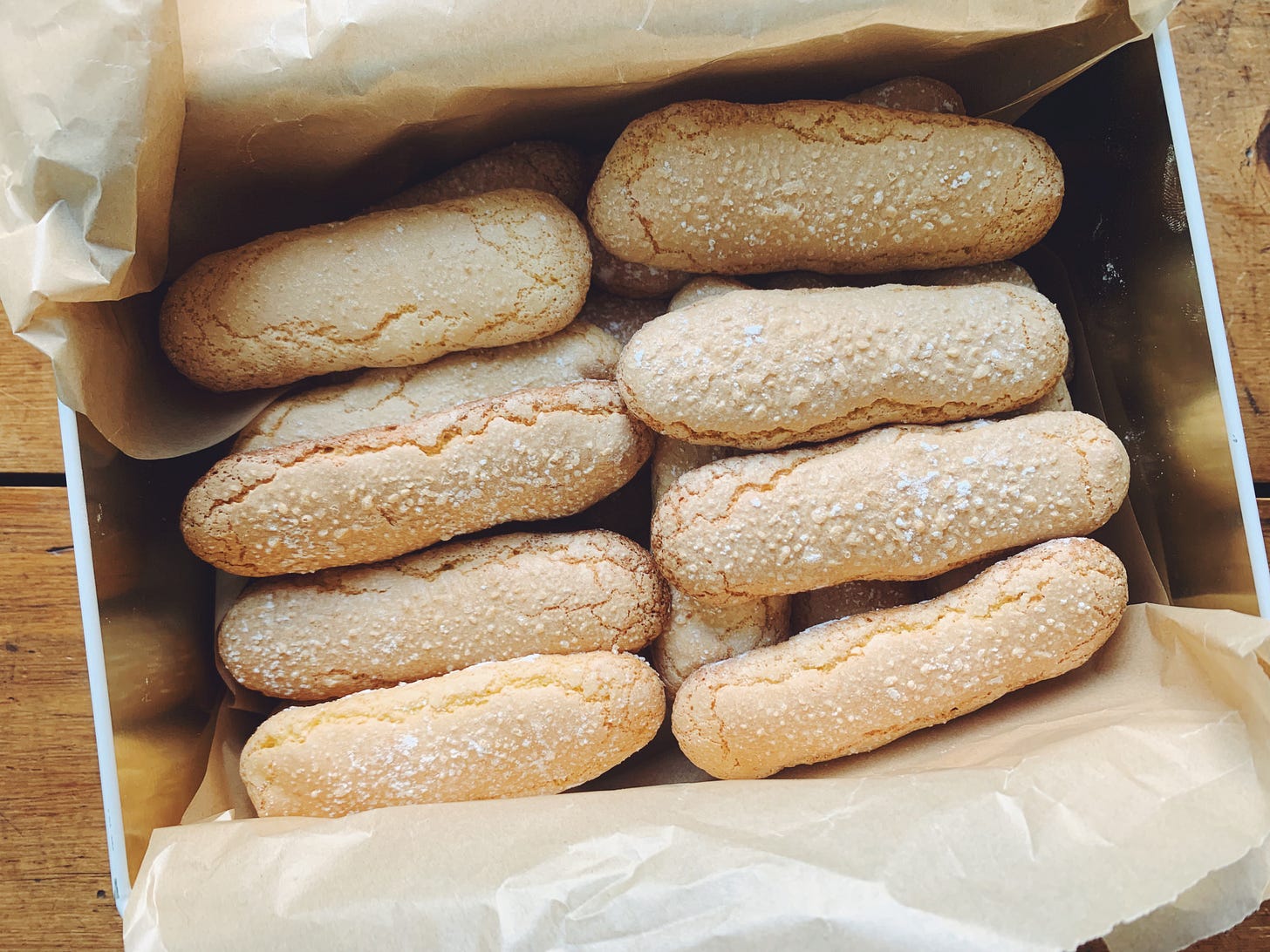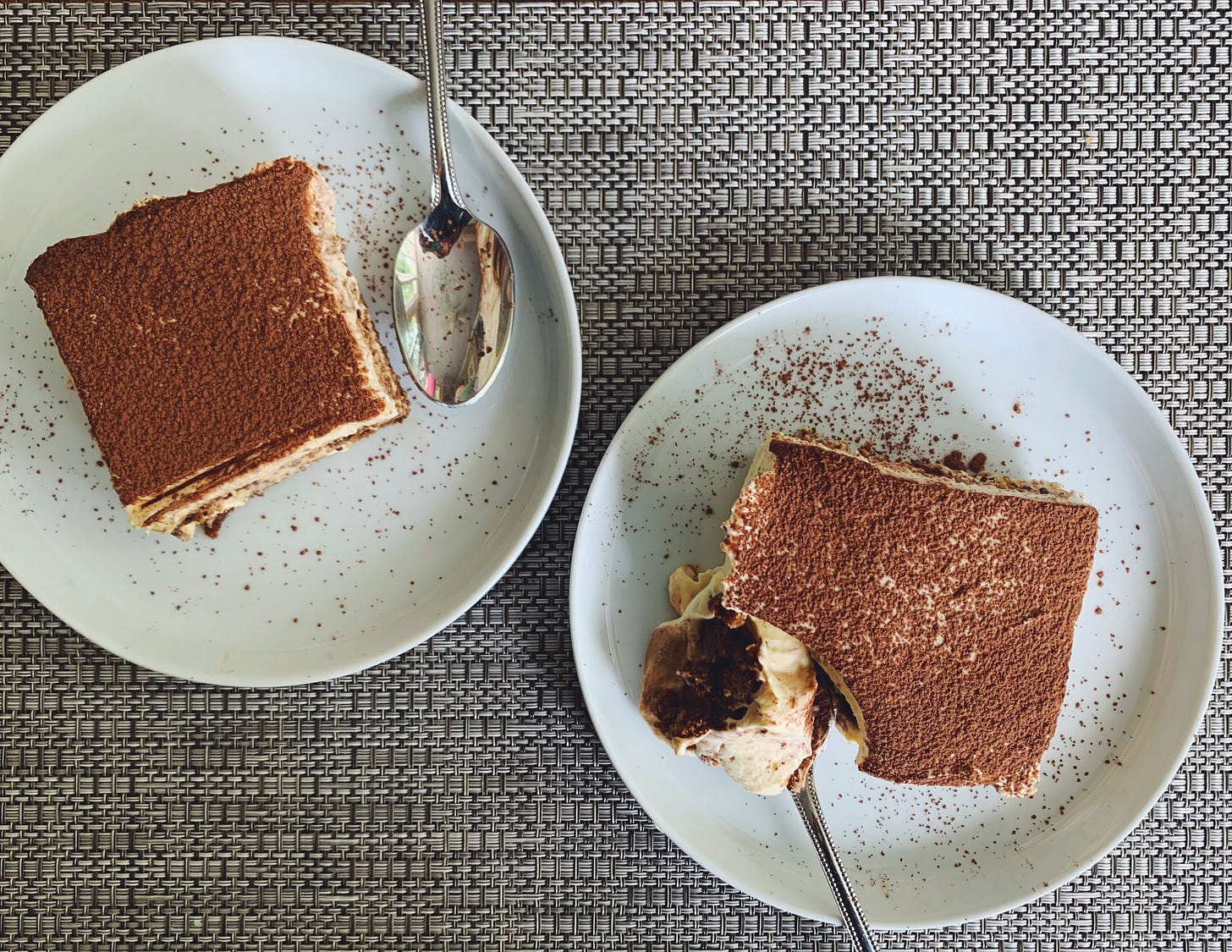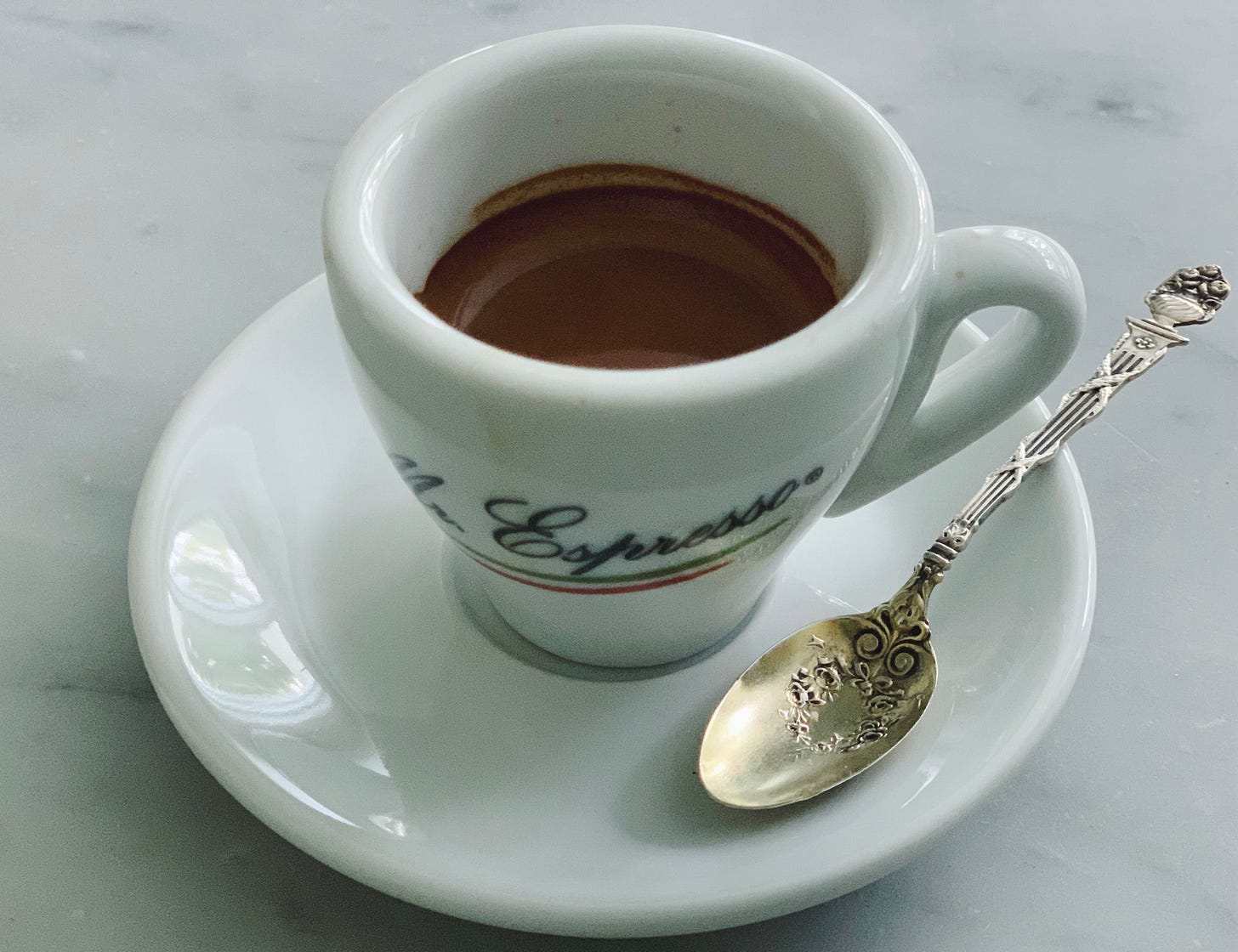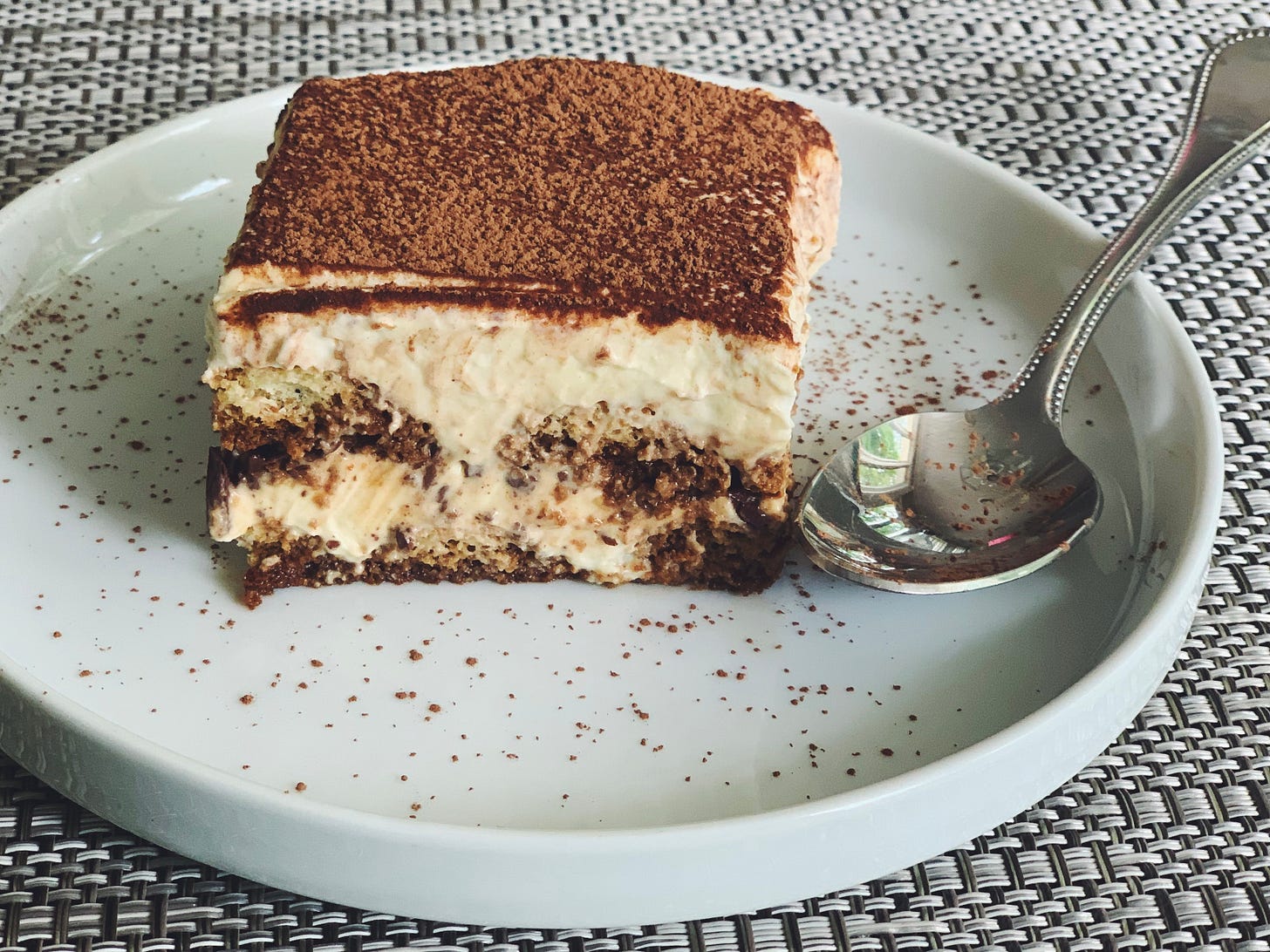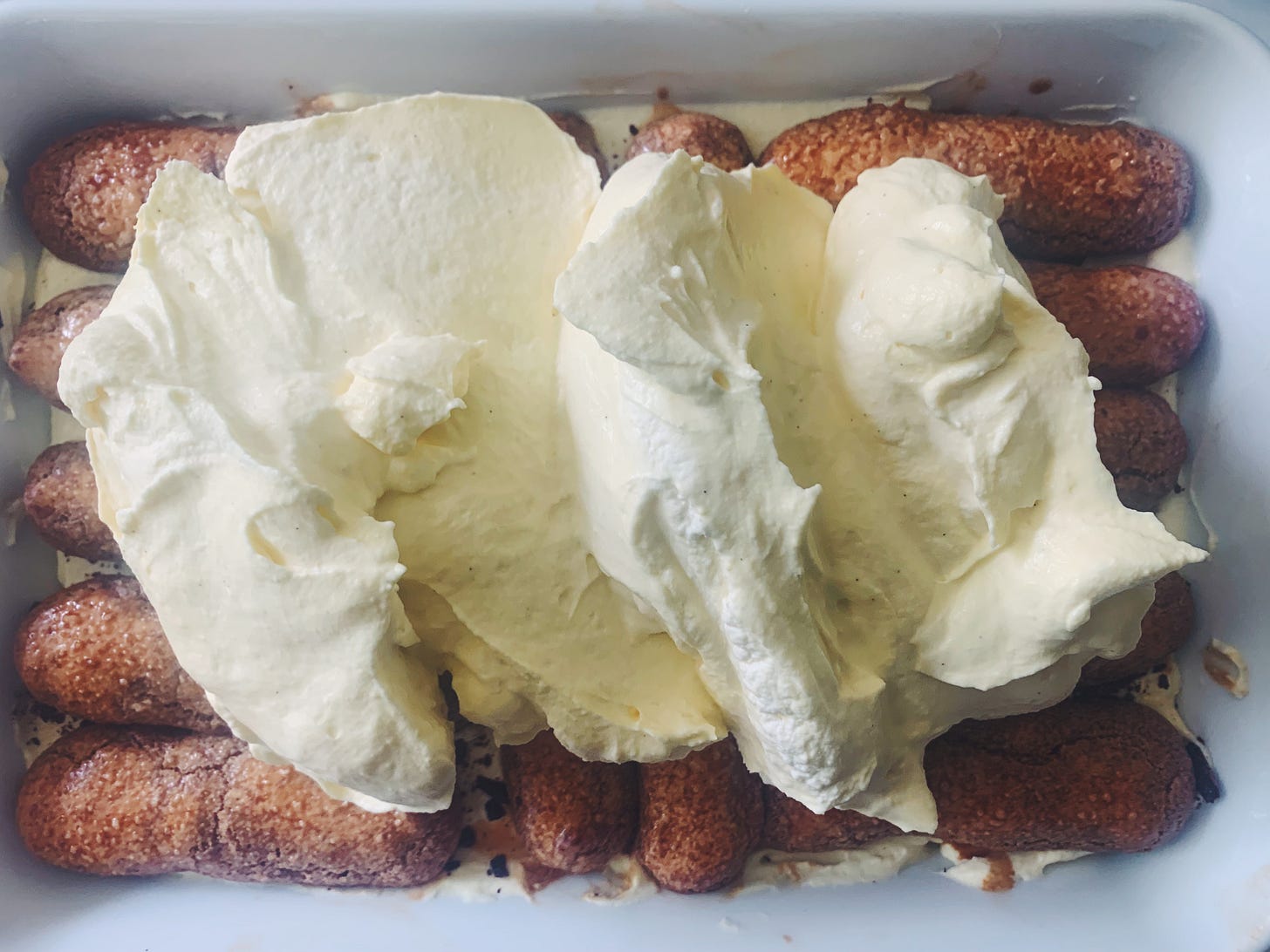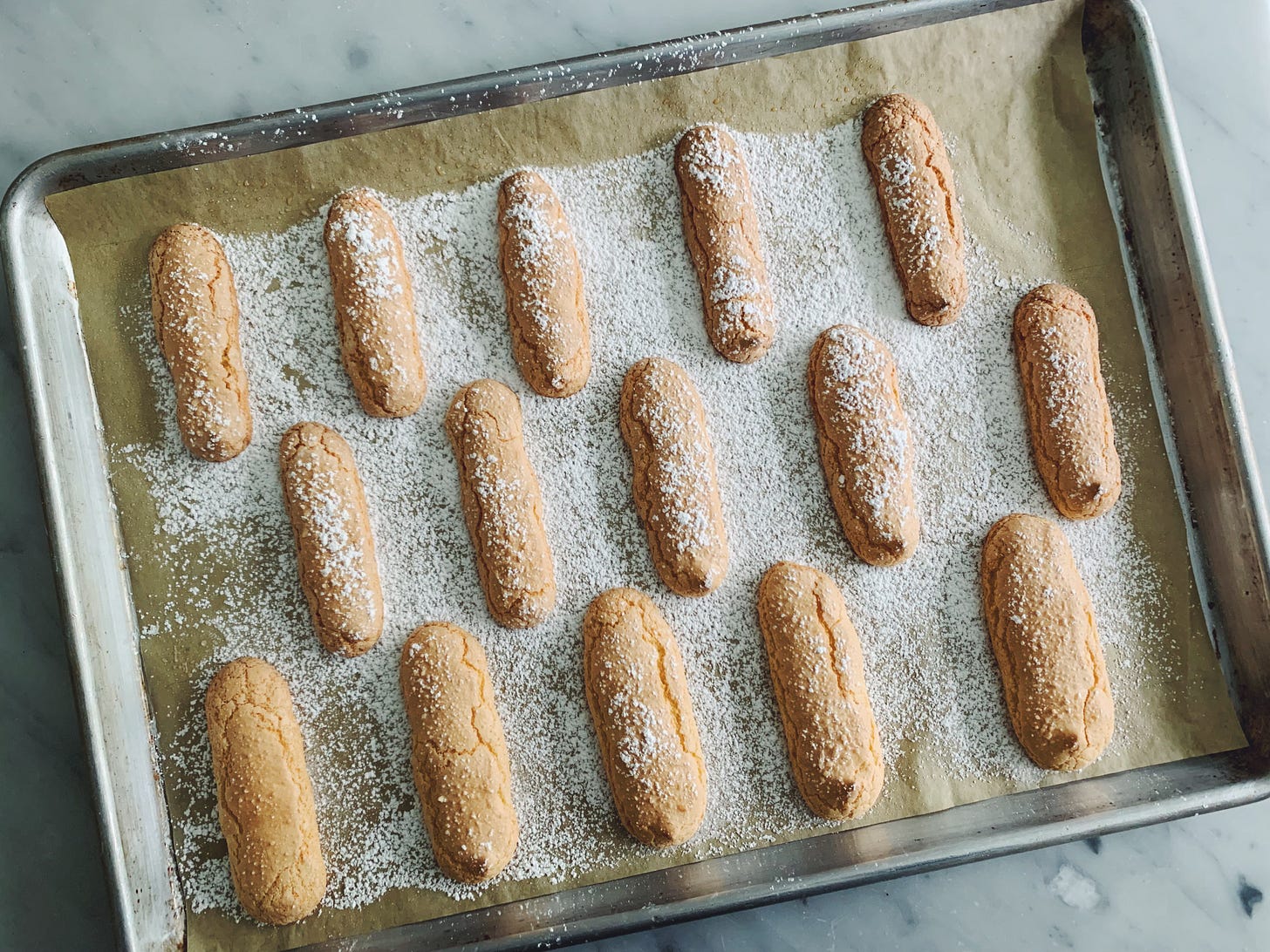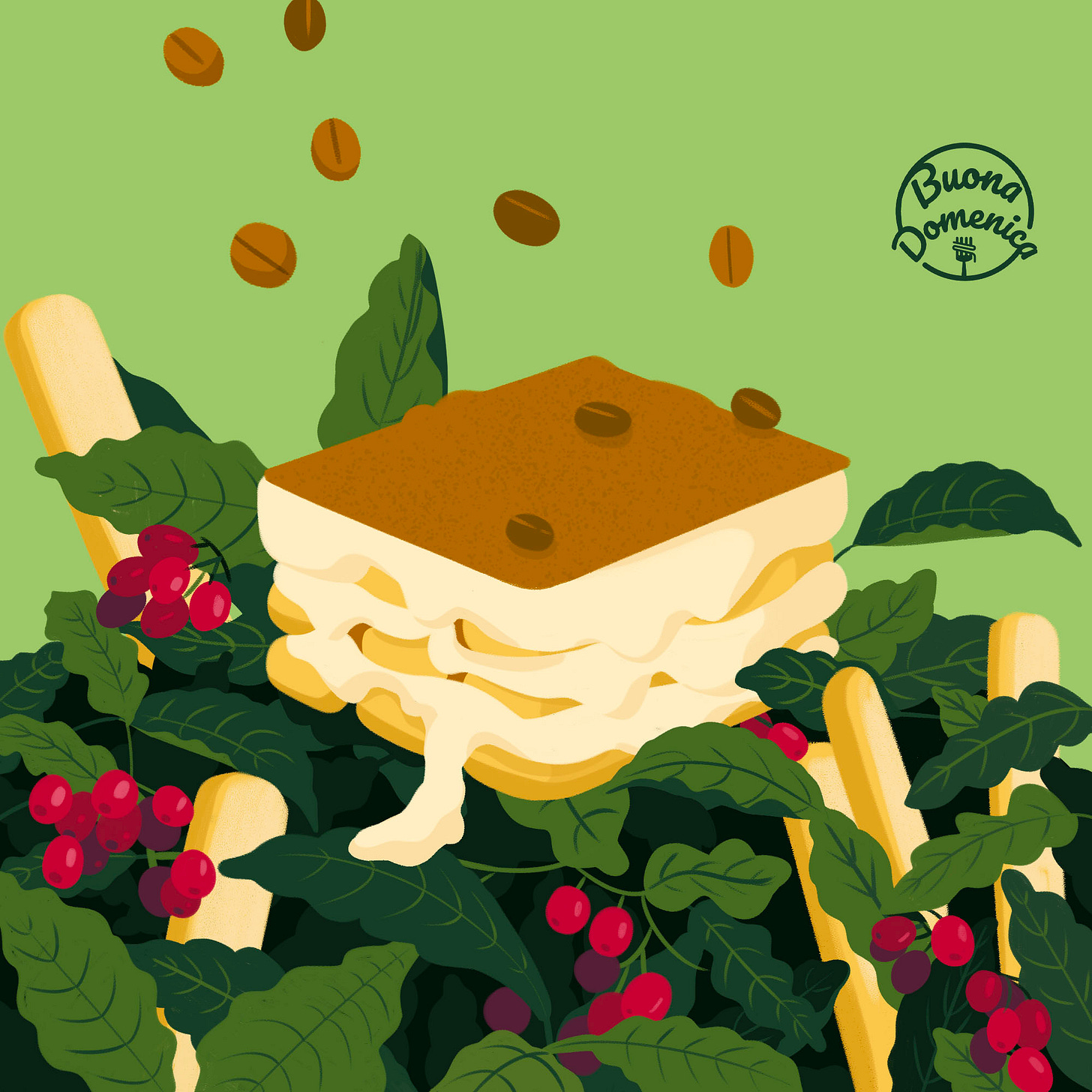
COOKBOOK GIVEAWAY WINNER: The winner of ‘s new cookbook, Cucina Povera, is Janice Knight! Janice, please look for an email from me.
On to this week’s newsletter.
I have not been kind to ladyfingers. In the past, I have maligned them as “weightless batons of dried sponge cake that hold little flavor and even less appeal.” In the great realm of Italian cookies, from rustic wine torcetti to elegant baci di dama, ladyfingers, or savoiardi, as they are called in Italy, seemed, to me, the least interesting of all, essentially little corpses of cookie dust. In tiramisù or trifles or any spoon dessert that called for them, I always replaced the ladyfingers—so pale and anemic!—with slices of rich pandoro or panettone, or sponge cake, or even, occasionally, pound cake.
I’ve changed my mind. Recently, while tweaking my tiramisù recipe, I decided to reconsider my rigid stance on ladyfingers. After all, a cookie that has lasted for 700+ years must be doing something right. There are various accounts (of course!) of the history of savoiardi, but most seem to agree that the cookie was created in the mid-14th century* by a chef in the House of Savoy for a banquet in honor of French royalty. The biscuit’s popularity was immediate and lasting. In Italy, you can find savoiardi, and its more recent relative, pavesini (a post-WWII creation) at most bakeries and supermarkets. In Sardegna they are known as pistoccus de caffè, and in Molise, prestofatti.
* Some accounts place the cookie’s debut in the 11th century, others in the 15th
In the early 20th century, ladyfingers crossed the Atlantic to the U.S. with French settlers. This tidbit from What’s Cooking America caught my eye:
Specialty Bakers Inc., a small bakery company on the banks of the Susquehanna River in Marysville, Pennsylvania, is known as “The Ladyfinger Specialist.” Virtually all the commercially available Ladyfingers in America have been baked by Specialty Bakers since 1901.
What really changed my mind, though, is that I made a batch and it was revelatory, as baking often can be. Not because my homemade savoiardi (pictured above) were so much better than store-bought; in fact, to my surprise, they tasted just like good quality commercial savoiardi. It’s more that by going through the process—beating egg yolks at length to create volume, whipping the whites to stiff, but still creamy, peaks, adding just enough vanilla and lemon zest to achieve that unmistakable flavor, folding everything together ever so gently and then piping out the airy oblong “fingers” onto a baking sheet—I finally came to understand and appreciate the cookie’s qualities: its delicate structure and gentle perfume, its impossible lightness, the way it holds air.
The recipe I used comes from “Britalian” baker Giuseppe Dell’Anno, winner of the 2021 Great British Bake Off and author of the recently published book Giuseppe’s Italian Bakes. Dell’Anno’s precise instructions were in no small part responsible for my success. “The traditional savoiardi recipe does not include any chemical raising agent, so the distinctive airiness is whipped in by beating the egg whites and yolks separately,” he writes in the recipe’s headnote. “So, although the recipe is quite simple, do not be tempted to cut down on the time required to incorporate enough air into the batter; this is essential to achieve the perfect structure.”
He’s right that the recipe is simple, though I imagine that originally it was quite laborious, as all that whipping and whisking had to be done by hand. Do you need to make homemade ladyfingers to make tiramisù? Of course not, but it is a fun little project. Plus, it is immensely satisfying to gaze upon a baking sheet of freshly baked savoiardi that you yourself made. At least that’s how I felt.
Below you’ll find the recipe for tiramisù; the savoiardi recipe is a bonus recipe for paid subscribers, so it is behind the paywall.
Let’s Talk Tiramisù
Obviously, once I had a tinful of homemade ladyfingers, there was no way I was not going to make tiramisù, coffee and cream lover that I am (Exhibit A, Exhibit B).
To make classic tiramisù, you beat egg yolks with sugar and then fold in mascarpone and, in some versions, whipped egg whites. You layer the airy cream over coffee-soaked ladyfingers and set the dessert in the fridge to rest overnight, then dust the surface with cocoa right before serving.
My version, which is based on my mom’s, isn’t all that different, except there is no raw egg. Mom gently cooked the egg yolks into a rich pastry cream, into which she folded mascarpone and whipped egg whites. I do the same, except I leave out the egg whites and instead fold in whipped cream. And I sprinkle shaved bittersweet chocolate in between the layers.
I don’t have an issue with raw egg, by the way, as long as the eggs come from a reliable source. When we were little, our mom and aunts used to feed my sister and me a morning treat we called “beaten egg,” which was really raw egg yolk beaten with sugar until pale, sometimes with a splash of hot espresso stirred in. It’s probably what accounts for my fondness for tiramisù in the first place.
In any case, this is, for the time being, my preferred method for making tiramisù, though I reserve the right to revisit my opinion at a later date.
COFFEE, the key ingredient
I haven’t yet mentioned coffee, but that is not to say it isn’t an important component of tiramisù. You could argue it is the most important component, as it is the bitter-fruity-earthy flavor of coffee that makes the dessert and gives it its name, “pick-me-up.”
Use high-quality espresso and brew it yourself, either with a stove-top Moka pot or an espresso machine. I’ve written before about my collaboration with Mr. Espresso, an Oakland, CA-based coffee roasting company that roasts their beans over oak wood. For those of us who can’t resist an Italian immigrant success story, Mr. Espresso has a good one. I used their Neapolitan espresso, a medium-dark roast with notes of chocolate, hazelnut, and caramel, for this recipe. And I spiked the coffee with just a splash of Cognac and Kahlua.
Readers: Where do you stand on this iconic dessert? Raw eggs? Cooked eggs? Booze? No booze?
RECIPE: Tiramisù
Make tiramisù the day before you plan to serve it. This gives all of its separate, delicious components—the savoiardi, the coffee, the mascarpone pastry cream—the necessary time to settle in together. Good, strong brewed espresso is essential.
To serve, slice the tiramisù into squares and served on a plate, or spoon it into shallow bowls or dessert glasses.
Makes about 10 servings
INGREDIENTS
For the pastry cream:
1 cup (240 ml) light cream
1/2 vanilla bean
6 large egg yolks
1/4 cup (50 g) sugar
1 tablespoon cornstarch
For the mascarpone cream:
1 pound (2 cups/454 g) mascarpone
1 1/2 cups (350 ml) heavy cream
1/4 cup (50 g) sugar
For the coffee dip:
1 cup (240 ml) freshly brewed espresso
1/4 cup sugar
1 tablespoon Cognac (optional)
1 tablespoon Kahlua (optional)
To assemble and serve:
2 to 3 dozen savoiardi, store-bought or homemade (recipe for homemade below)
2 to 3 tablespoons shaved bittersweet chocolate
1/2 cup (50 g) unsweetened cocoa powder
INSTRUCTIONS
1. Make the pastry cream. Pour the cream into a medium saucepan and scrape in the seeds from the half vanilla bean. Add the pod and bring just to a simmer over medium heat. Remove from the heat, cover, and let steep for 5 minutes. Discard the vanilla bean pod.
2. Whisk the yolks, sugar, and cornstarch together in a medium bowl until everything is well combined, and the mixture is lightened in color. Slowly dribble the hot milk into the egg yolks, a little at a time, whisking vigorously all the while to prevent the eggs from cooking. Pour the mixture back into the saucepan and cook on low, stirring constantly, until it thickens. This should take about 5 minutes. Once the mixture begins to thicken, stir vigorously; it will thicken fast. Remove it from the heat immediately and stir stir stir to prevent lumps. Pass the cream through a fine-mesh sieve into a bowl, cover the surface with plastic wrap, pressing it right on the surface of the cream, and refrigerate until chilled. (If you want to speed up the chilling, you can place the bowl inside a larger bowl filled with ice and stir it until it is cool.)
3. Make the mascarpone cream. Chill a metal bowl and beaters or whisk attachment in the freezer for 10 to 15 minutes. (This will make whipping easier.) Then combine the mascarpone and heavy cream in the chilled bowl and mix on low (be careful for sloshing) until the two are incorporated, then increase the speed and beat until thickened. Pour in the 1/4 cup sugar and whip until stiff.
4. Gently fold (don’t stir) the chilled pastry cream into the whipped mascarpone cream, using top-to-bottom strokes to prevent the mascarpone cream from deflating. Cover and place in the refrigerator to keep chilled.
5. Brew the espresso—you may not need a full cup, but it’s better to have too much than too little. Stir in 1/4 cup sugar and the Cognac and Kahlua. Let cool to room temperature.
6. Assemble the tiramisù. Use an 8 x 12-inch baking dish for a two-layer tiramisù, or a smaller (8-inch square) vessel for three layers. For a two-layer, you’ll need about 2 dozen savoiardi; for a three-layer you’ll need about 3 dozen. Have all your components—the mascarpone-pastry cream, the coffee, the savoiardi, and the shaved bittersweet chocolate—ready. Quickly dip the savoiardi, one at a time, into the coffee and arrange them in the bottom of the dish so that they are touching and completely cover the bottom. Don’t let the savoiardi linger in the coffee or they will fall apart. If you like, you can sprinkle a little more coffee on top of the savoiardi after you have nestled them together, but don’t overdo it; they will also be absorbing moisture from the mascarpone cream, which will further soften them.
For a two-layer tiramisù, spoon half the mascarpone pastry cream on top of the savoiardi and level it with a spatula. Sprinkle 1 to 2 tablespoons shaved bittersweet chocolate on top. Arrange a second layer of coffee-dipped savoiardi on top, and spread the remaining mascarpone cream on top, smoothing it out evenly (ideally it should reach the top of the dish). If you want to be a little fancier, you can pipe the second layer of mascarpone cream rather than spread it.
For a three-layer tiramisù, arrange a layer of coffee-dipped savoiardi on the bottom of the serving dish and top with 1/3 of the mascarpone pastry cream and about 1 tablespoon shaved chocolate. Make a second layer of coffee-dipped savoiardi, followed by a second layer of mascarpone cream and a second sprinkle of bittersweet chocolate. Add a final layer of coffee-dipped savoiardi and a final layer of mascarpone pastry cream, spreading it out evenly or piping it.
Cover the dish tightly with wrap and place it in the refrigerator overnight. Right before serving, dust the top of the tiramisù generously with cocoa powder. (Don’t do this ahead of time, as the cocoa powder will absorb moisture and look splotchy). Serve cold.
RECIPE: Homemade Savoiardi
I never thought I would become a lover of ladyfingers, but ever since I baked them myself, I’ve come around.
Keep reading with a 7-day free trial
Subscribe to Buona Domenica to keep reading this post and get 7 days of free access to the full post archives.




